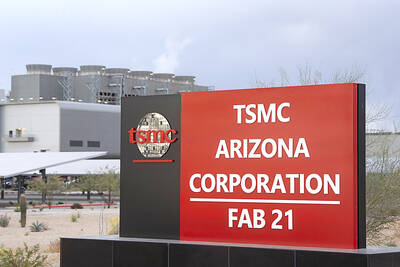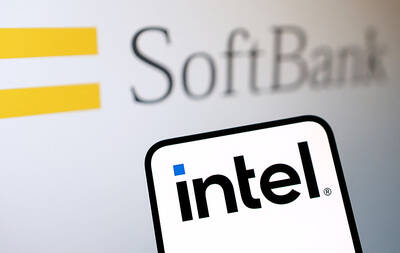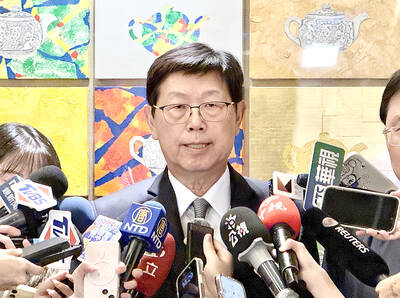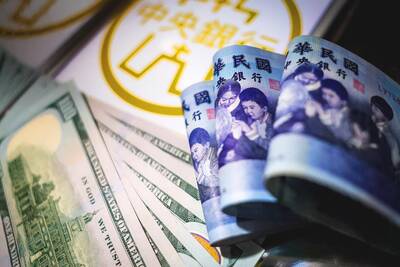The Japanese government yesterday launched a US$16.7 billion scheme to buy shares in companies threatened by the financial storm in a new move to ease the credit crunch that has starved key industries of cash.
Japan’s central bank is already buying corporate debt to help firms raise funds and the government has offered funds to help banks lend more. However, sliding exports and frozen credit markets still threaten industrial firms at the heart of Japan’s economy.
Confirmation of the capital injection scheme pushed Japanese stocks higher, taking the Nikkei share average’s gains for the day to 4.6 percent, but dragged on already falling bonds and the yen.
“For the moment, this is a positive for the stock market,” said Soichiro Monji, chief strategist at fund manager Daiwa SB Investments.
“Bankruptcies have been increasing, and not only among financial firms. There have been reports that funding has been tight at many large corporations. This is a plus in that it should help ease that funding squeeze,” Monji said.
Japan is following in the footsteps of the US, which has also gone beyond banks to bail out its auto sector on the argument that the credit crunch threatens firms by removing their access to cash.
Tokyo’s move may provide a lifeline for small and medium enterprises, which account for about 70 percent of employment in Japan and which are finding it much harder than big corporates to raise funds in the credit crunch.
While individually small, such firms are crucial suppliers to big brand manufacturers.
They have been hit hard by sliding demand for Japanese cars, technology and other exports, with industrial production sliding at a record pace and no signs yet of a turnaround.
“We want to support companies that we think are important for Japan and for regional economies, regardless of their size,” Japanese Economy, Trade and Industry Minister Toshihiro Nika said.
Japanese bankruptcies jumped 24 percent last month from a year earlier, including 33 among listed firms — the highest annual tally in at least 60 years.
The government capital will be provided through its affiliated banks buying shares in both listed and unlisted companies, the ministry said.
The ministry had set aside ¥1.5 trillion (US$16.7 billion) to cover any losses that result, an official said.
The money would only go to firms facing difficulty in fund-raising because of market turmoil, and those receiving the funds will be required to draw up plans to boost profitability within three years, the ministry said in a statement.
“We’re not specifying any sectors. Our ministry looks at manufacturers and companies in the service sector, but firms that are in the scheme aren’t limited to the sectors that our ministry oversees,” a ministry official said.
The government has not yet decided what class of shares would be bought, the official said, although Japanese media said at the weekend it would likely be through non-voting preferred stock.
In related news, South Korea has set aside around US$2.9 billion in emergency state funds that can be tapped to help the economy shake off its worst crisis in a decade, officials said yesterday.
The government has allocated four trillion won in reserve funds for this year, compared with 2.4 trillion won last year, the ministry of strategy and finance said.
It is the largest amount allocated to state emergency funds in six years.
“In the case of emergency, the government could tap the funds immediately without the need to seek a supplementary budget,” a ministry official told Yonhap news agency.
The government has announced extra spending and tax cuts worth billions of dollars to try to prop up the economy and is also frontloading this year’s budget spending in the first half as much as possible.
Last week South Korean President Lee Myung-bak replaced his finance minister and other key economic officials in an effort to better cope with the slump.
Asia’s fourth-largest economy shrank 5.6 percent quarter-on-quarter in the fourth quarter compared with a 0.5 percent expansion in the third quarter. It was the worst showing since the first quarter of 1998.
Year-on-year the economy shrank 3.4 percent in the fourth quarter compared with 3.8 percent growth in the third.
The annualized figure showed the biggest fall since the fourth quarter of 1998, when it contracted 6 percent.
For the whole of last year, South Korea’s economy grew 2.5 percent, sharply down from a 5 percent expansion in 2007.
The government’s forecast for this year is for 2 percent growth, but some think-tanks and investment banks are forecasting an outright recession.

Taiwan Semiconductor Manufacturing Co (TSMC, 台積電), the world’s biggest contract chipmaker, booked its first-ever profit from its Arizona subsidiary in the first half of this year, four years after operations began, a company financial statement showed. Wholly owned by TSMC, the Arizona unit contributed NT$4.52 billion (US$150.1 million) in net profit, compared with a loss of NT$4.34 billion a year earlier, the statement showed. The company attributed the turnaround to strong market demand and high factory utilization. The Arizona unit counts Apple Inc, Nvidia Corp and Advanced Micro Devices Inc among its major customers. The firm’s first fab in Arizona began high-volume production

VOTE OF CONFIDENCE: The Japanese company is adding Intel to an investment portfolio that includes artificial intelligence linchpins Nvidia Corp and TSMC Softbank Group Corp agreed to buy US$2 billion of Intel Corp stock, a surprise deal to shore up a struggling US name while boosting its own chip ambitions. The Japanese company, which is adding Intel to an investment portfolio that includes artificial intelligence (AI) linchpins Nvidia Corp and Taiwan Semiconductor Manufacturing Co (TSMC, 台積電), is to pay US$23 a share — a small discount to Intel’s last close. Shares of the US chipmaker, which would issue new stock to Softbank, surged more than 5 percent in after-hours trading. Softbank’s stock fell as much as 5.4 percent on Tuesday in Tokyo, its

COLLABORATION: Softbank would supply manufacturing gear to the factory, and a joint venture would make AI data center equipment, Young Liu said Hon Hai Precision Industry Co (鴻海精密) would operate a US factory owned by Softbank Group Corp, setting up what is in the running to be the first manufacturing site in the Japanese company’s US$500 billion Stargate venture with OpenAI and Oracle Corp. Softbank is acquiring Hon Hai’s electric-vehicle plant in Ohio, but the Taiwanese company would continue to run the complex after turning it into an artificial intelligence (AI) server production plant, Hon Hai chairman Young Liu (劉揚偉) said yesterday. Softbank would supply manufacturing gear to the factory, and a joint venture between the two companies would make AI data

DOLLAR SIGNS: The central bank rejected claims that the NT dollar had appreciated 10 percentage points more than the yen or the won against the greenback The New Taiwan dollar yesterday fell for a sixth day to its weakest level in three months, driven by equity-related outflows and reactions to an economics official’s exchange rate remarks. The NT dollar slid NT$0.197, or 0.65 percent, to close at NT$30.505 per US dollar, central bank data showed. The local currency has depreciated 1.97 percent so far this month, ranking as the weakest performer among Asian currencies. Dealers attributed the retreat to foreign investors wiring capital gains and dividends abroad after taking profit in local shares. They also pointed to reports that Washington might consider taking equity stakes in chipmakers, including Taiwan Semiconductor